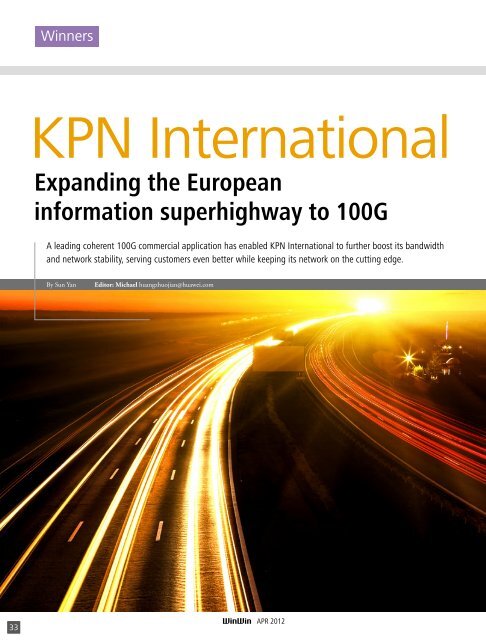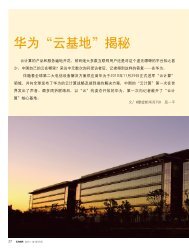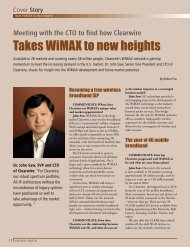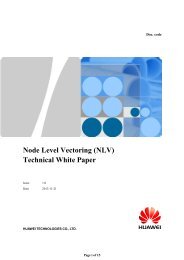Download - Huawei
Download - Huawei
Download - Huawei
Create successful ePaper yourself
Turn your PDF publications into a flip-book with our unique Google optimized e-Paper software.
Winners<br />
KPN International<br />
Expanding the European<br />
information superhighway to 100G<br />
A leading coherent 100G commercial application has enabled KPN International to further boost its bandwidth<br />
and network stability, serving customers even better while keeping its network on the cutting edge.<br />
By Sun Yan<br />
Editor: Michael huangzhuojian@huawei.com<br />
33<br />
APR 2012
Winners<br />
KPN’s WDM backbone is now one of the largest in Europe,<br />
providing a wide spectrum of services such as wavelength,<br />
international private line, VPN (MPLS and Ethernet) and IP transit,<br />
plus a multitude of value-added services.<br />
rollout with <strong>Huawei</strong> as its partner. Over four<br />
months, KPN deployed a network of 3,000 km<br />
connecting more than twenty major European<br />
cities, including Amsterdam, Luxembourg,<br />
Brussels, Frankfurt, and London, making it one<br />
of the largest WDM backbone networks of its<br />
kind in Europe. In this context, the operator<br />
had ample bandwidth to launch and accelerate<br />
its international private line, international voice,<br />
VPN, and wavelength services.<br />
From 2006 to 2008, global IP traffic grew<br />
explosively. Global backbone WDM traffic<br />
increased by more than 40% annually, and slightly<br />
faster in Europe (44%); 40G interfaces for core<br />
routers had matured, and routers with 40G linecards<br />
were being deployed worldwide. With 40G<br />
transmission commercially available on a limited<br />
basis, KPN saw great potential in 40G leasing.<br />
In September 2008, KPN secured an order for<br />
40G service between Amsterdam and London. The<br />
40G network, however, had to span the English<br />
Channel, which presented an enormous challenge.<br />
The possibilities for setting up intermediate<br />
wavelength regeneration sites seemed remote, as<br />
the channel averages 180 km in width.<br />
<strong>Huawei</strong>’s diverse experience in 40G deployment<br />
won KPN over once again. Both parties worked<br />
to assess KPN’s networks and compare different<br />
solutions. Finally, 40G eDQPSK technology,<br />
with its excellent transmission capability and<br />
compatibility with KPN’s existing infrastructure,<br />
was finally chosen. <strong>Huawei</strong> helped KPN upgrade its<br />
35<br />
APR 2012
sites and install 40G service boards. In only three<br />
weeks, KPN established a stable 40G transmission<br />
link spanning 214 km of the channel.<br />
Promising the future: 40G to 100G<br />
In 2010, IEEE 802.3ba, the 40G/100G<br />
Ethernet standard, was officially released, which<br />
helped jump-start the development of its industrial<br />
chain; 100G applications were maturing thanks to<br />
joint efforts between vendors and operators.<br />
By early 2011, KPN had been serving customers<br />
in 22 European countries through its WDM<br />
backbone network. Service growth, however,<br />
had led to bottlenecks, with the Amsterdam-<br />
London link being one of the major choke points,<br />
while users of the Amsterdam-Luxembourg link<br />
were demanding 100G speeds to smoothen their<br />
interactions with content providers and system<br />
integrators. After its successful 40G rollout,<br />
KPN expected that a 100G upgrade, based on its<br />
platform, would also be possible, with <strong>Huawei</strong>’s<br />
help.<br />
Early in 2008, <strong>Huawei</strong> launched its 100G<br />
prototypes and worked with more than ten<br />
operators to verify 100G on live networks. In the<br />
two years that followed, <strong>Huawei</strong> improved its 100G<br />
solutions. When KPN foresaw that their network<br />
would lead to bottlenecks, they started discussions<br />
with <strong>Huawei</strong> to test the 100G solution on the<br />
platform to increase the capacity in what were then<br />
bottlenecked links. KPN’s networks had mixed<br />
10G and 40G services, with greater demand on<br />
nonlinearity resistance. In addition, their network<br />
used both G.652 and G.655 fiber, creating CD and<br />
PMD tolerance problems. <strong>Huawei</strong> recommended<br />
its 100G coherent detection solution for the<br />
upgrade.<br />
The cooperation between both parties<br />
culminated in a successful upgrade of the<br />
Amsterdam-London and Amsterdam-Luxembourg<br />
links; the former extends over 500 km, including<br />
the aforementioned link across the English<br />
Channel, and functions without electrical<br />
regeneration, while the latter spans more than 600<br />
km, including the urban fiber. Thanks to these<br />
efforts, KPN can now call itself one of the first<br />
operators to deploy 100G commercially.<br />
“KPN International is committed to providing<br />
users with reliable, fast and innovative services. The<br />
leading coherent 100G commercial application<br />
enables us to secure large bandwidth and high<br />
stability requirements on our network and serve<br />
our customers even better,” said Jasper Snijder,<br />
Managing Director of KPN International.<br />
“Due to <strong>Huawei</strong>’s leading WDM solutions, our<br />
international network remains at the cutting-edge,<br />
providing high performance to accommodate fastgrowing<br />
service demands.”<br />
In the future, KPN is expected to continue<br />
expansion of its ultra-broadband services through<br />
migration of its busiest links to 100G.<br />
APR 2012<br />
36
















